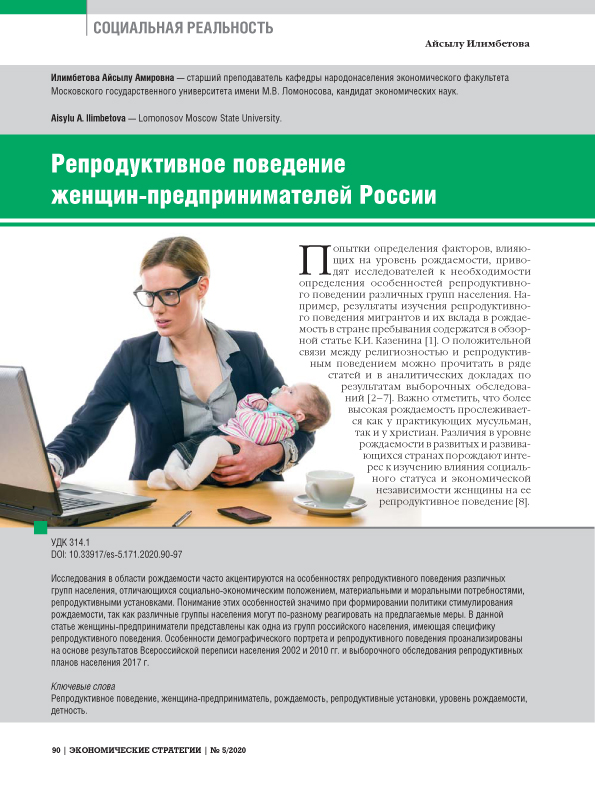Reproductive Behaviour of Female Entrepreneurs in Russia
DOI: 10.33917/es-5.171.2020.90-97
Research in the field of fertility often focuses on peculiarities of reproductive behaviour of various groups of population different
in socio-economic status, material and moral needs and reproductive attitudes. Comprehension of these features is important when shaping a pro-birth policy, since different groups of the population may respond differently to the proposed measures. In the article women entrepreneurs are presented as one of the groups of the Russian population with specific reproductive behaviour. The features of demographic profile and reproductive behaviour are analyzed on the basis of results of the All-Russian population census of 2002 and 2010 and a sample survey of the population reproductive plans of 2017
References:
1. Kazenin K.I. Rozhdaemost’ v sem’yakh migrantov: dannye, gipotezy, modeli (obzor zarubezhnykh issledovanii) [Natality in Migrant Families: Facts, Hypotheses, Models (Foreign Studies Review)]. Demograficheskoe obozrenie, 2017, no 4, pp. 6–79.
2. Immerman R.S., Mackey W.C. Religion and fertility. The mankind quarterly, 2003, no 43, pp. 377–408.
3. Westoff C.F., Bietsch K. Religion and Reproductive Behavior in Sub-Saharan Africa. DHS Analytical Studies. Rockville, Maryland, USA: ICF International, 2015, no 48, p. 40, available at: https://dhsprogram.com/pubs/pdf/AS48/AS48.pdf.
4. Kulu H., Hannemann T. Why does fertility remain high among certain UK-born ethnic minority women. Demographic research, 2016, no 35, pp. 1441–1488, available at: https://www.demographic-research.org/volumes/vol35/49/35-49.pdf.
5. Adsera A. Marital Fertility and Religion: Recent Changes in Spain. Institute for the Study of Labor Bonn (IZA). Discussion Paper, no 1399, 2004, p. 41, available at: http://papers.ssrn.com/sol3/papers.cfm?abstractid=621063.
6. Blume M., Ramsel C., Graupner S. Religiosity as a demographic factor — An underestimated connection? Marburg Journal of Religion, 2006, no 11, pp. 1–22.
7. Frejka T., Westoff C.F. Religion, Religiousness and Fertility in the US and Europe // European Journal of Population, 2008, no 24, pp. 5–31.
8. Mason K.O. The Impact of Women’s Social Position on Fertility in Developing Countries Sociological forum, 1987, no 1, pp. 284–300.
9. Vserossiiskaya perepis’ naseleniya 2002 goda [All-Russian Population Census 2002]. Federal’naya sluzhba gosudarstvennoi statistiki, available at: http://www.perepis2002.ru/index.html?id=11.
10. Vserossiiskaya perepis’ naseleniya 2010 goda [All-Russian Population Census 2002]. Federal’naya sluzhba gosudarstvennoi statistiki, available at: https://gks.ru/free_doc/new_site/perepis2010/croc/perepis_itogi1612.htm.
11. Vyborochnoe obsledovanie reproduktivnykh planov naseleniya 2017 [Sample Survey of the Population Reproductive Plans in 2017]. Federal’naya sluzhba gosudarstvennoi statistiki, available at: https://gks.ru/free_doc/new_site/RPN17/index.html.
12. Kalachikova O.N., Shabunova A.A. Reproduktivnoe povedenie kak faktor vosproizvodstva naseleniya: tendentsii i perspektivy [Reproductive Behaviour as a Factor of Human Reproduction: Trends and Prospects]. Vologda: ISERT RAN, 2015, p. 5.
13. Arkhangel’skii V.N. Reproduktivnoe i brachnoe povedenie [Reproductive and Mating Behaviour]. Sotsiologicheskie issledovaniya, 2013, no 2, pp. 129–136.
14. Andreev E., Zakharov S. Mikroperepis’-2015 stavit pod somnenie rezul’tativnost’ mer po stimulirovaniyu rozhdaemosti [Microcensus 2015 Calls into Question Effectiveness of Measures Stimulating the Birth Rate]. Demoskop Weekly, 2017, no 711–712, available at: http://www.demoscope.ru/weekly/2017/0711/demoscope711.pdf.
15. Zakharov S.V. Potentsial strukturnykh faktorov rosta rozhdaemosti ischerpan? [Is the Potential for Structural Factors of Fertility Growth Exhausted?]. Demoskop Weekly, 2017, pp. 731–732, available at: http://www.demoscope.ru/weekly/2017/0731/demoscope731.pdf



